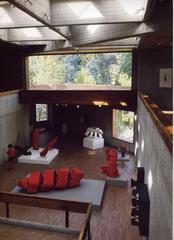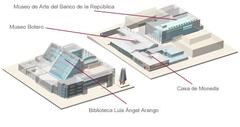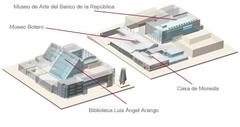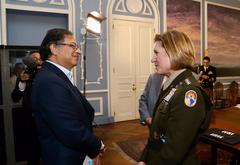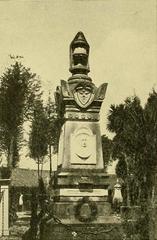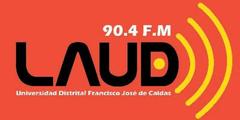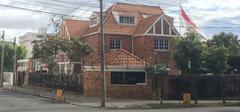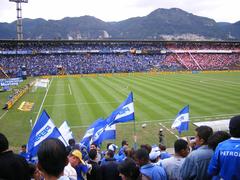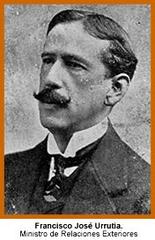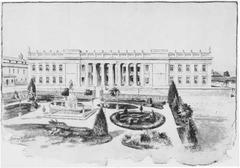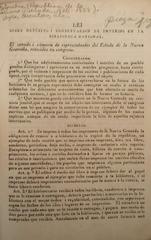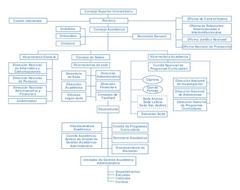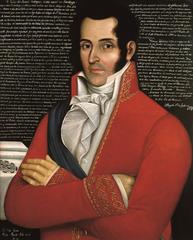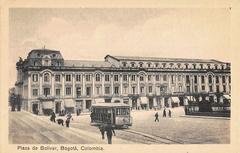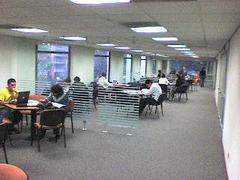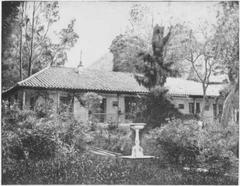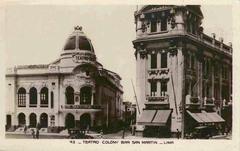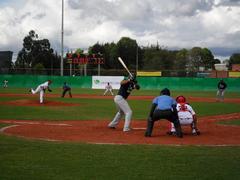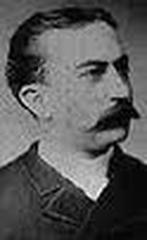Palacio de San Carlos Visiting Hours, Tickets, and Bogotá Historical Sites Guide
Date: 04/07/2025
Introduction
Nestled in the historic La Candelaria district of Bogotá, the Palacio de San Carlos stands as one of Colombia’s most important historical and architectural landmarks. With origins dating back to the late 16th century, this neoclassical palace has played a pivotal role in the nation’s colonial, republican, and modern diplomatic history. Once the residence of Simón Bolívar and the scene of a dramatic assassination attempt, today it serves as the headquarters of the Ministry of Foreign Affairs. This guide offers a detailed overview of the palace’s history, architecture, significance, and practical information for visitors—covering visiting hours, ticket policies, accessibility, and nearby attractions. Whether your interests lie in history, politics, or architecture, a visit to the Palacio de San Carlos provides a unique window into Colombia’s cultural legacy (Cancillería; Wikipedia; Lonely Planet).
Table of Contents
- Introduction
- Historical Overview
- Architectural Highlights
- Visitor Information
- Practical Travel Advice
- Frequently Asked Questions (FAQ)
- Conclusion
- Sources
Historical Overview
Colonial Beginnings and Jesuit Influence
The construction of the Palacio de San Carlos began in 1585, originally commissioned by Francisco Porras Mejía, Archdeacon of the Bogotá Cathedral. The palace first served as a private residence for the Porras Mejía family, reflecting the grandeur of colonial aristocracy (Wikipedia; Canal Institucional). In 1605, it was acquired by Archbishop Bartolomé Lobo Guerrero and transformed into the Colegio Seminario de San Bartolomé, a Jesuit seminary integral to the city’s educational and religious life.
A key 18th-century milestone was the establishment of Bogotá’s first printing press at the palace in 1739, marking its significance in the intellectual and cultural awakening of the era. Following the expulsion of the Jesuits in 1767, the building was repurposed as the Royal Library of Santa Fe and later as barracks for the Presidential Guard (Wikiwand).
The Bolivarian Era and Presidential Residence
The 19th century saw the palace become central to Colombia’s political transformation. After an earthquake in 1827 rendered the original presidential residence uninhabitable, Simón Bolívar authorized the acquisition of the palace, which became the official seat of the new Republic of Colombia in 1828 (Canal Institucional). The palace was the site of the infamous 1828 assassination attempt on Bolívar, known as the “Noche Septembrina,” from which he narrowly escaped thanks to Manuela Sáenz (Historica Fandom; Wikiwand). This episode is memorialized by a plaque at the window through which Bolívar fled.
From 1828 to 1908, the Palacio de San Carlos remained the official residence of the President of Colombia, serving as a backdrop for major events in the nation’s formative years.
Diplomatic Role and Restoration
In 1908, the presidential residence moved to Casa de Nariño, and the Palacio de San Carlos was designated as the Ministry of Foreign Affairs headquarters (Visit Bogotá). The palace briefly resumed its role as a presidential home from 1954 to 1980. Significant restorations and expansions took place in the 20th century, including a new façade designed by Pietro Cantini in 1937 and the integration of adjacent historic buildings.
During the 1948 Bogotazo riots, the palace sustained interior damage, but subsequent restoration ensured its preservation. Its status as a National Monument, granted in 1975, underlines its enduring importance (Cancillería).
Architectural Highlights
Palacio de San Carlos is a masterwork of neoclassical and colonial architecture. The building is organized around elegant courtyards—most notably the romantic Patio de la Palma, featuring a walnut planted by Bolívar and a palm planted by President López.
Key features include:
- Main Entrance & Vestibule: A stately stone portal leads to a vestibule decorated with 18th-century Spanish furnishings and bronze vases.
- Salón Francisco de Paula Santander: The palace’s most ornate state room, adorned in gold, with silk damask walls, a rococo mirror, and colonial portraits.
- Simón Bolívar’s Bedroom: Preserved in period detail, with a 17th-century bed and Bolívar’s writing desk.
- Salón de Audiencias: The largest hall, notable for its hunting-motif carpet and green silk walls.
- Sala Indalecio Liévano Aguirre: The former Council of Ministers’ room, featuring red velvet walls and a walnut table.
- Salón Protocolario: An intimate, library-like space with a Mudejar coffered ceiling.
- Pompeian Dome: A frescoed ceiling by Santiago Martínez Delgado, depicting virtues and muses.
- Staircase and Bronze Bolívar: The grand staircase displays the bronze model by Pietro Tenerani, used for the Bolívar statue in Plaza de Bolívar (Cancillería).
Visitor Information
Visiting Hours & Tickets
- Guided Tours: Typically available Tuesday–Friday, 9:00 AM–12:00 PM and 2:00 PM–4:00 PM.
- Admission: Free, but advance reservation is required due to security protocols. Visits are by guided tour only.
- How to Book: Check the official Ministry website or contact the Ministry for up-to-date schedules and booking procedures.
Accessibility
- The palace has made efforts to improve accessibility, but some areas may remain challenging due to its historic design. Visitors with mobility needs should notify the Ministry in advance.
Photography & Tips
- Photography is allowed in most areas, but restrictions may apply to protect artifacts and ensure security. Flash photography and tripods are generally prohibited—always ask your guide before taking photos.
Nearby Attractions
- Plaza de Bolívar: Bogotá’s central square, featuring the cathedral and National Capitol.
- Museo del Oro: Renowned gold museum, a short walk away.
- Teatro Colón: Historic theater adjacent to the palace.
- Museo Botero: Featuring works by Colombia’s most famous artist.
Practical Travel Advice
- Weather: Bogotá’s climate is cool and variable; always bring a waterproof jacket or umbrella (Xixerone).
- Altitude: At 2,640 meters (8,660 feet), take precautions against altitude sickness by hydrating and avoiding strenuous activity on your first day (Xixerone).
- Language: Basic Spanish phrases go a long way; most tours are in Spanish, with some guides available in English (Xixerone).
- Safety: La Candelaria is generally safe by day, but remain vigilant with your belongings and avoid unlit streets at night (Xixerone).
Frequently Asked Questions (FAQ)
Q: Do I need to buy tickets to visit Palacio de San Carlos?
A: No tickets are required; admission is free, but visits must be booked in advance as part of a guided tour.
Q: Is Palacio de San Carlos wheelchair accessible?
A: There is partial accessibility. Notify the Ministry ahead of your visit to discuss specific needs.
Q: Can I take photographs inside the palace?
A: Photography is allowed in most areas, but ask your guide for permission and restrictions.
Q: Are there virtual tours?
A: Occasionally, the Ministry offers virtual tours—check the official website for updates.
Q: What nearby attractions should I visit?
A: Plaza de Bolívar, Museo del Oro, Teatro Colón, and Museo Botero are all within walking distance.
Conclusion
The Palacio de San Carlos is not only an architectural gem but also a living testament to Colombia’s journey from colonial outpost to modern republic. Its storied halls, lush courtyards, and ornate salons are imbued with the legacy of leaders, diplomats, and pivotal national events. A visit here—whether in person or virtually—connects you to the heart of Colombian history. Always check the latest visiting hours and book your guided tour in advance through the official Ministry website. Combine your visit with nearby cultural sites for a comprehensive Bogotá experience.
For cultural explorers, history enthusiasts, and architecture lovers alike, the Palacio de San Carlos is an essential stop in Bogotá’s historic center. Download the Audiala app for curated tours, maps, and up-to-date travel tips, and follow us on social media for the latest updates on Colombia’s heritage destinations.
Alt text: Main stone entrance of Palacio de San Carlos with colonial balcony and iron railings.
Alt text: View of the central courtyard featuring Tuscan columns and arches.
Alt text: Bolívar’s bedroom showing the 17th-century bed and colonial furniture.
Sources and Further Information
- Canal Institucional: Historia del Palacio de San Carlos
- Wikipedia: Palacio de San Carlos, Bogotá
- Cancillería de Colombia: Historia del Palacio
- Visit Bogotá: San Carlos Palace
- Cancillería: Bicentenario Palacio de San Carlos
- Lonely Planet: Palacio de San Carlos
- Xixerone: Mistakes to Avoid in Bogotá
For official updates, visit the Ministry of Foreign Affairs of Colombia and Bogotá Tourism.


